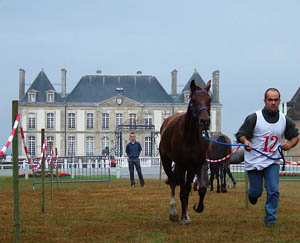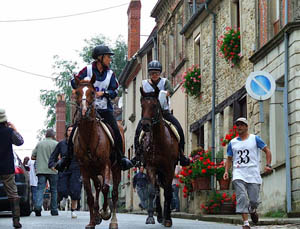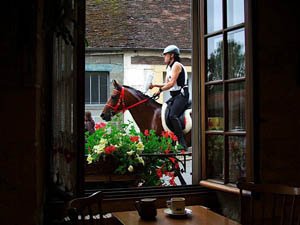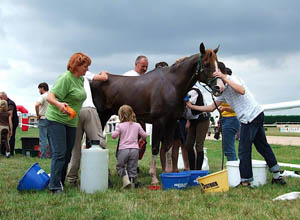|

Endurance in
Argentan, France

Requires Google Earth
Endurance in France
2008 Argentan
Images by Team Nellie
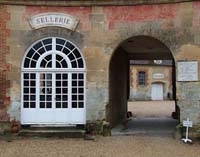
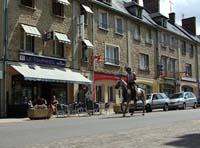
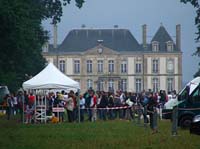
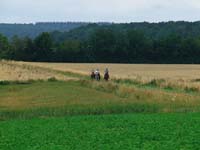


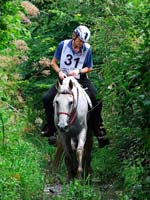
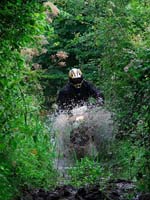
2008 Argentan CEI** 120km
 |
 |
Images of the Day by Team Nellie
This year only the swallows and the farmers kept their side of the deal. You can always rely on a farmer to moan. Round here they're driving A class Mercedes, and when they cross a field to bring in some cows they wear more bling than Snoop Doggy Dogg, but they're still all doom and gloom. Maybe the girl didn't turn up to polish their Krugerrands; I don't know.
Anyway, the weather confounded all expectations by baking the ground hard for a month then changing to overcast and uncomfortably muggy for the morning of the ride; the sort of day when you wish it would get on with it and rain.
This time last year teamnellie was there to compete, Richard riding a horse from Brittany who was having his first attempt over the distance and on whom heewed with the horsehen you're riding you see things in terms of mud or overhanging branches, flat sections to put on speed, hills to climb up or run down. If you're racing around in a car trying to get to a crew point, your day is bends negotiated, traffic lights cursed at. You might get a fleeting glimpse of a big house, an old church, some kind of plaque, a monument. You have no idea, really, of where you are.
This ride starts and finishes at the local racetrack, as do many major rides in France, and the first section of 27km uses old farm and forestry tracks in a series of long, straight and fairly flat runs to the first vet gate, at the Haras du Pin.
In 1714 King Louis XIVth's 'first horseman', one Franapproved' stallions. On the eve of the French Revolution, the Stud accounted for 196 stallions and 132 "approved horses". After a period of uncertainty, the State-run stud institution and the associated stallion farms were reinstated by Imperial Decree - the gold-plated bees that are worked into the wrought iron main gates are one of the symbols of Napoleon I.
The Haras dg use of an electronic timing system so there were no queues of crew waiting at the tables for pieces of paper, just a discreet mini-headcollar with sensors on the horse, wires under a line of sand at all entry points, and a network of Asus Eeepc laptops to make sense of it all. Glorious when it works, and thankfully it did.
The timing system had been brought up from Southern France by its devisor Franpy about this or not I couldn't say, but it does mean that, even though the premier endurance event in this part of the country, it has retained a delightful family atmosphere.
Three or four times a year the Family Pivain and their little eleven year-old arab mare enter a 90k ride and, though they sometimes withdraw after the first vetgate if they feel Aurore D-be decided ride organisers had it too easy (joke) and to bring the sport into line with other equestrian disciplines by insisting you choose between riding under a professional, amateur or club license. With a club license you can only ride up to 60k (38 miles) so Saturdayched a David-style attack on the French Goliaths in 2005, finishing fifth European in the Championships. They both took a year's rest from endurance last year and it was lovely to see them back. Caroline Paul, a young smiling rider from Brittany was riding her father you ask a mare but you negotiate with a stallion".
The second stage is thought to be the hardest of the ride, in the sense of "most technical". It's 35 km of hill work, and the tracks up and down those hills are secret little byways and hidden lanes that are muddy and wet and have been rutted and churned by tractors. First, though there's a climb into the little town of Exmes itself, a get-off-and-lead climb, before a clatter down through the medieval main street, and into the dark woods. Last year Richard turned a corner into a clearing just here and came upon a vision, a young blonde lady wearing what seemed to be a short nightdress, sitting bareback on a huge white carthorse like some angelic hippy love goddess, with a beautiful blonde child in front of her. No-one mentioned her this year so presumably she's moved on. But then, no-one else seemed to have seen her last year, either...
To the rider it seems like a succession of hills, but looked at on the map it becomes clear that the route is snaking up and down the same two or three escarpments over and again, with one main bluff commanding a view over the plain back towards Argentan. There's a big war memorial up here, at Mont-Ormel. Somewhere here is the wooded hill on which, on August 18th 1944, the 1st Polish Armoured Division made their stand in preparation to block the escape of a 50,000 strong German Panzer Division as they raced to get through the "Trun-Chambois gap". Trun and Chambois are two small towns less than 10km apart on the plain north of Argentan. Between them ran the last road to safety for the German forces, which is still here, and goes straight through the tiny village of St Lambert-sur-Dive.
Beneath Mont-Ormel memorial a tiny track drops down the cliff and through the back gate into an equestrian centre whose amiable Irish proprietor serves excellent cheese baguettes and holds to the belief that a bottle of wine, once opened, must be finished. Although Andre Coriou, on his good horse Jolie Quatre Vents, had moved up 12 places to take the lead earlier it was Catherine Richard who came into view first, quickly followed by a group of ten. No Coriou. Suddenly he appeared, with four others who had formed the head, coming in from the wrong direction. During a vain attempt to avoid branches and brambles Andre had missed a marker and put on an extra 2km - and incurred a 9 minute disadvantage from which he would never really recover.
Richard remembers the next, third section as the hardest; not for technical reasons - it's pretty much flat - but because, at 37km it's the longest. Not only that but while the first 10km are in the direction of home the route then doubles back for another 10km. A horse can lose morale.
We headed straight for the first village, to see the horses through, and found ourselves in St Lambert-sur-Dive. If you're a rider, you come down a lane towards the church here. Just by the church your crew meet you with water, you tend to your horse and you're gone. The cars do a u-turn and head to the next place.
The Polish general named his hill "Maczuga", or "Mace". As well as the retreating Panzer division he intended to head off a second army attempting to break through and rescue their comrades. Throughout August 20th German units able to slip past the 4th Canadian Armoured Division at Trun, together with SS units on the other side of the gap, stormed the Polish position ceaselessly. Surrounded, and running low on food, fuel, and ammunition, the Poles held fast until relieved the next day by The Canadian Grenadier Guards. In all, they lost 2,300 men. But in a stunning display of valour, the unwavering Polish soldiers had sealed the fate of the German forces in Normandy. However, on August 18th, armoured cars of the South Alberta Regiment and infantry from The Argyll and Sutherland Highlanders of Canada had left Trun for St Lambert-sur-Dive.
The battle group assigned to capture St Lambert consisted of 175 men and 16 tanks. They were commanded by Major David Currie, a 'veteran' of 10 days combat and two years training, to whom it immediately became clear that the village was full of German troops determined to protect the bridge and crossroads. The church tower was being used as a look-out. Two of Currie's tanks were immediately disabled; he rescued the crews and posted his men for all-round combat.
After 6 hours of fighting they were only half-way through (yesterday I walked through that village; it took just over 1 minute). Over the next two days outnumbered and isolated Canadians waged war against a desperate enemy. Currie, with all his officers killed or wounded, kept his lines intact, shouting encouragement to his thinning ranks and directing the fire of his few remaining guns. He single-handedly knocked out one of the giant Tiger tanks. In 60 hours of continuous combat the unit destroyed seven tanks, a dozen pieces of heavy artillery and killed, wounded or captured 2,900 enemy soldiers. When the fighting stopped, Currie fell asleep standing up.
For his "courage and complete disregard for personal safety ...his conspicuous bravery and extreme devotion to duty" Currie was awarded the Victoria Cross, the highest military decoration in the British Commonwealth.
Typhoon pilots strafing the retreating German lines reported being overcome by the smell of death. Dwight Eisenhower described "a luxuriant countryside where all life had brutally ceased". Sometimes, it's important to get off your horse and find out about the land you're riding over.
Through Trun, past the memorial to another, earlier conflict, then the ride turns back south towards the hippodrome. Many rides in France are "clover-leaf" events - a series of loops back to the same place. These are excellent news for organisers, who don't have to worry about bussing vets and timekeepers all over the countryside, and quite good for crews, who can set up a base camp. For a horse it can be wearying, being asked to go out again and again, and for this reason rides like Argentan - a 100km loop followed by a 20km loop - are popular with riders. But it's still asking a lot of a horse to go back out when, understandably, he thinks he's done for the day, and so it is with mixed feelings that one feels one's horse brighten up and quicken again as he realises he's on his way home. Furthermore, even if you pass, the third vet gate of an FEI 120 features a compulsory representation with Ridgeway ten minutes before the horse sets back out; a lot of stiffnesses and some metabolic issues get picked up here.
Along the sides of field after field of corn which, if not as high as an elephantnd Fabrice Creignou on Dune d'Azat and Annick Thiepault on Ourmak Ar Veuzic. Ourmak, after a rather excitable first vetting, presented immediately and therefore gained a valuable couple of minutes. In the amateur section Caroline Paul, who was riding Lamtara faster than heare their podium.
A slightly surreal feature of this ride is that the last couple of kilometres go through a housing estate, across a municipal playground and along the back of some allotment gardens, then across a final corn field before bursting through a gap in a hedge onto the racetrack. Serrand had kept Aragon just behind Thiepault and Creignou until they hit the final bend,then he spread his hands out wide in a way that would not gain approval from Willie Schumaker and let Aragon go, to float a length ahead in a way that Schumaker would have been very happy with.
Aragon was given as much time to recover as possible (20 minutes). He dragged Erwan into the vetting area before his metabolics were taken - 56 bpm - and then, as is the way here, trotted out last, all the others having successfully passed the vet. He broke into canter on the return, so had to be trotted again, but this was only to observe the rules. It was clear to everyone that today Aragon, a multi-tasking sort of animal who has covered over 30 mares this season and once bit a chunk out of his owner's cheek for daring to stroke him while he was eating, was, as his overjoyed rider said, "a true horse".
Team Nellie






